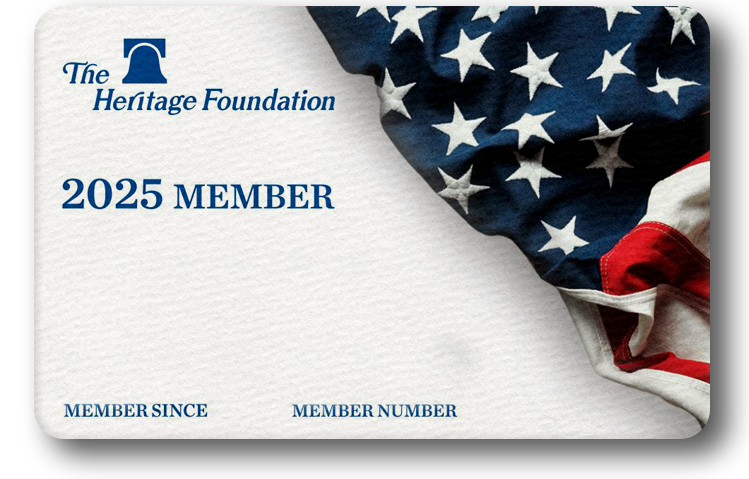Internet users are not always shielded from obscene content despite filters. Filtering and blocking software often fail to block obscene content, and it can over-filter information on medical treatment, drugs and alcohol, and relationships. Many children also use devices outside the home without protection.REF While filters are helpful, they do not eliminate the risk of exposure.
Parents who spend long hours online tend to have children who do the same. Many parents express confidence in filters, yet 48 percent admit that the tools block obscene content rarely or only some of the time.REF This finding reveals a discrepancy between what parents generally believe to be true about filters and the reality of their effectiveness. Additionally, half of parents believe the software always works, but half also admit that their children use unprotected devices, or they are unsure if they do. The data are clear: Parents need more solutions than filtering and blocking software.
Background
Filtering and blocking software are widely available tools—including free options and fee-based models—for parents to employ to shield their children from certain content like obscenity. Schools and libraries are required by federal law to use Internet filters to receive subsidies for telecommunications services.REF However, four problems persist with filters and blocking software:
- They often fail to shield children from obscene content;
- They may unnecessarily prevent access to non-obscene content;
- Children can often disable or circumvent the filter; and
- Not every device a child has access to has the technology installed or enabled.
Despite technological advances in recent years—from faster internet speeds to artificial intelligence—online filters and blocking software fail to consistently capture obscene content. Before this year, the most recent published study on the effectiveness of content filtering and blocking software came from the United Kingdom in 2017.REF Since then, growing evidence has underscored the harms that children face online, particularly from pornography. Parents, advocates, experts, and lawmakers are calling for greater online safeguards to protect children. Supporters for additional safeguards often argue that filters are not sufficient, and opponents of additional protections say that parents should simply use filters consistently and personally oversee their children’s online activity. It was clear that newer data on filters and blocking software were needed.
The Heritage Foundation commissioned a study produced by J.L. Partners in January 2025 that sampled 1,001 parents of children between the ages of four and 18 who use content blockers.REF Fifty-six percent of the respondents were mothers and 44 percent were fathers; 64 percent of respondents were white, 10 percent Hispanic, and 20 percent black. The survey also asked what type of school the respondents’ children attended: 72 percent said public school, 8 percent public charter school, 7 percent private (non-religious) school, 6 percent private (religious) school, and 5 percent homeschool. Among the respondents’ children, 84 percent had no disability and 15 percent did. The survey’s margin of error is 3.4 percent. Children themselves were not surveyed. Parents answered for their children based on their perception and awareness. The survey does not reflect testing or technical analysis of various filtering and blocking software or methods. This Backgrounder analyzes survey findings and supplements them with external research findings to explain why high screen time matters and why protecting children from obscene content is critical.
Children and Pornography
Protecting children from obscenity is important because it robs them of their innocence, assaults their senses, and corrupts their morals. Additionally, children’s brains are developing and exposure to pornography influences arousal templates in the brain. This exposure establishes harmful, foundational sexual scripts for life and changes the neuroplasticity by remodeling the brain’s learning and reward pathways. Children with heavy exposure may learn to perceive exploitation, coercion, and sexual abuse as normal. This deception has significant consequences on their views of and behavior toward the opposite sex, the same sex, and their beliefs about what constitutes a healthy relationship.REF The harms of exposure to pornography extend beyond sexuality, increasing the risks for anxiety, depression, low self-esteem, and poor body image, and the likelihood of emotional, social, and sexual problems in adult life. Chronic porn consumption can affect academic performance, hinder working memory, lead to poor decision-making, and increase addictive behaviors.REF It can also impede marriage and family formation later in life.
The problems caused by online pornography have led 25 states to pass legislation requiring pornography websites to verify that their users are 18 or older.REF In June 2025, the Supreme Court upheld one of those laws (Texas’s HB 1181) in Free Speech Coalition v. Paxton. The Court determined that the law only incidentally burdened protected speech and that adults do not have a First Amendment right to avoid age verification. The Supreme Court provided legal certainty for current and future age verification laws, but culturally, many adults remain unconvinced and skeptical of age verification. (In a previous paper, this author made the case for age verification, so will not focus on that here.)REF This Backgrounder provides recent data on filtering and blocking software, contextualizes it, and explains why parents cannot rely on software alone to shield their children from online obscenity.
Shielding children from online pornography is increasingly difficult since 95 percent of children in the U.S. have access to a smartphone.REF The same percentage of kids also use social media, and pornographic content creators often promote their material on social media to drive traffic to their websites. Multiple websites provide step-by-step guides for creators explaining how to promote their erotic content on social media.REF Increasingly, social media serves as a gateway to pornography websites. Filtering and blocking software must not only detect and block pornographic websites, as was the case in the early years of web browsing. They also need to detect and block pornographic content on websites and platforms that are not generally used for publishing or viewing pornography.
Internet Usage Among Survey Respondents
The survey revealed high numbers of daily online usage among parents and their children: 82 percent of parents spend between four and 12-plus hours online during the week, and 79 percent spend between four and 12-plus hours online during the weekend. Fifty-two percent of the children of surveyed parents spend between four and 12-plus hours online during the week and 61 percent spend that amount during the weekends. These numbers show a correlation between parents who have high rates of online usage and children who have high rates of online usage. The numbers for children are significant because external research indicates that children with heavy reliance on screens are at risk of impaired cognitive, linguistic, and social-emotional growth.REF Findings by the U.S. Surgeon General reveal that adolescents who spend more than three hours a day on social media face twice the risk of poor mental health outcomes.REF
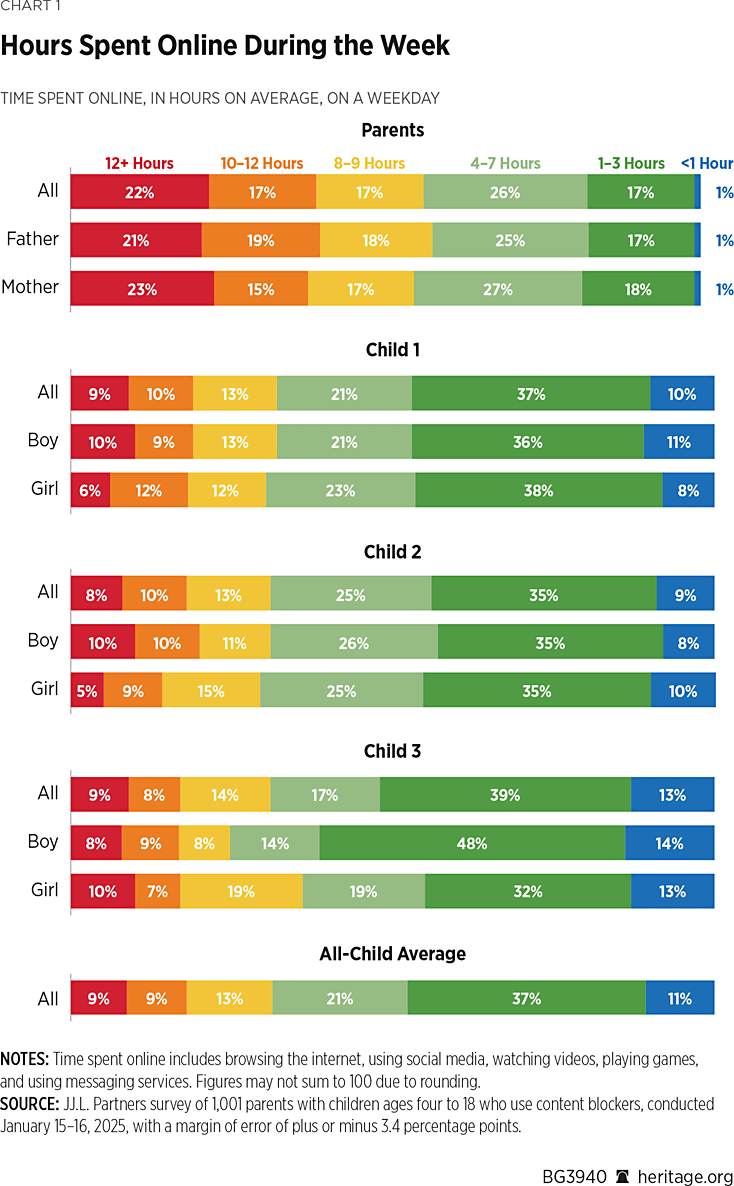
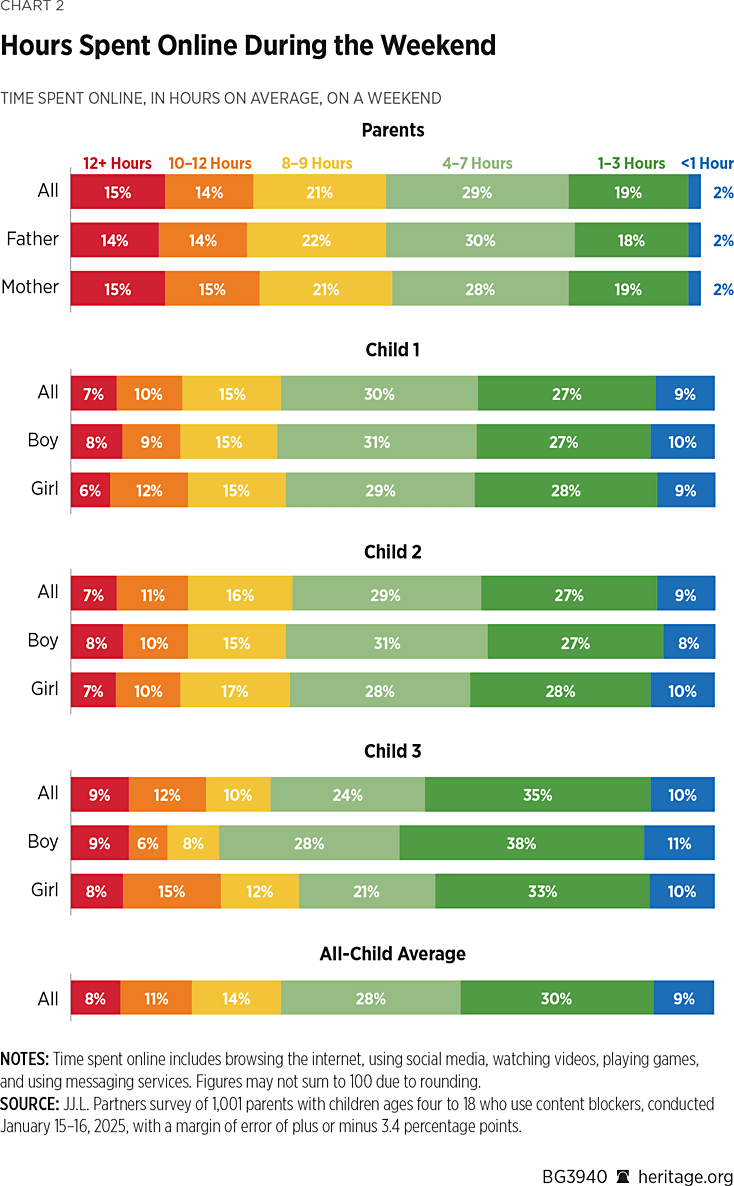
Content Filtering and Blocking Software Usage
The survey excluded parents who did not use filtering and blocking software, meaning that all 1,001 parents used filtering or blocking software. More than half (54 percent) of these parents use a built-in device software (such as Apple’s Screen Time Settings, Windows Firewall, and Google SafeSearch) to shield access to online pornography. Thirty-eight percent rely on in-browser filters (such as Safe Search for DuckDuckGo, Google SafeSearch, Internet Explorer Parental Controls, and Web Filter for Firefox); 22 percent pay for a third-party software (such as Covenant Eyes, Canopy, and FamiSafe); and 20 percent report using free third-party software (such as OpenDNS and Cloudflare). Built-in device software options were the most common for all age groups, but older parents are more likely to use in-browser filters and younger parents tend to use fee-based software.
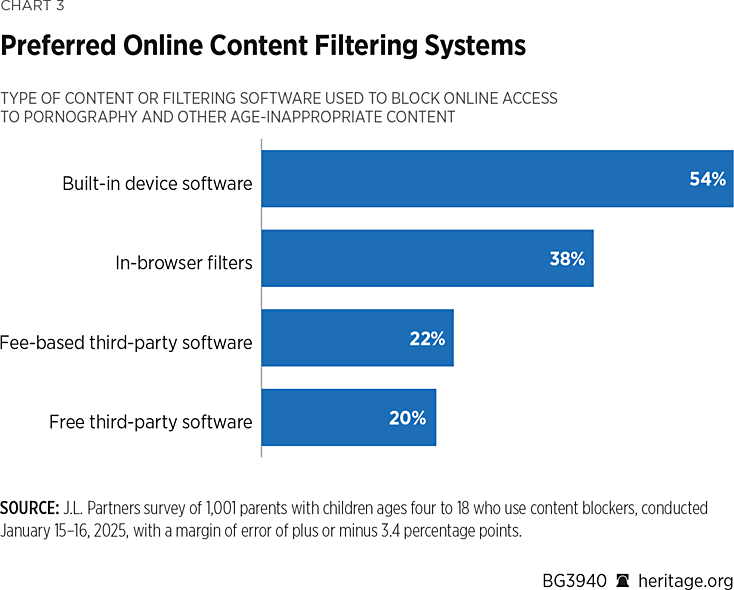
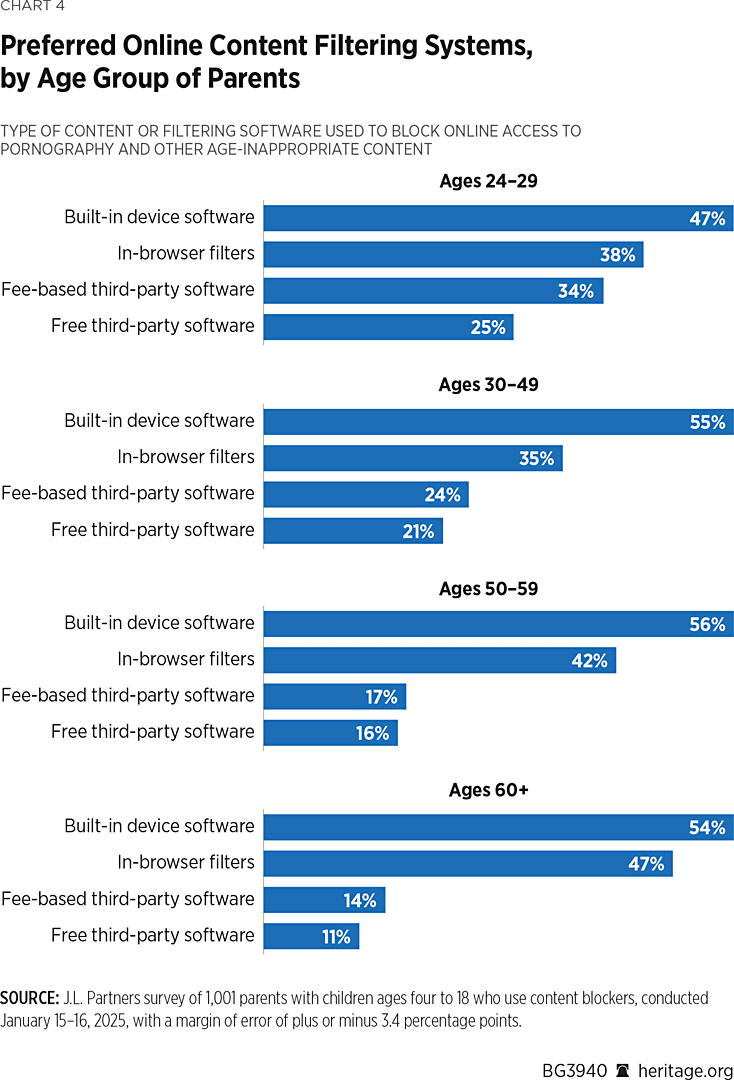
The most popular types of software used are FamiSafe, Canopy (fee-based software), Cloudflare (free third-party software), Apple’s Screen Time Settings (built-in device software), and Google SafeSearch (available on Google products and devices). Parents reported Google and Apple’s content filtering software to be the most effective. Parents spend between $0 and $70 per month for content blocking software with $12 per month as the average; 37 percent of parents spend $0 per month on their content blocking software.
Sixty-nine percent of parents said that the devices their children have access to (including the child’s personal device, the parents’ devices, and a family computer) have blocking or filtering software enabled. Teenagers, who are most likely to seek out pornography, were less likely to have software enabled on their devices with 63 percent of teens 13 years to 15 years old and 65 percent of teens 16 years to 18 years old reported by their parents to have it enabled.
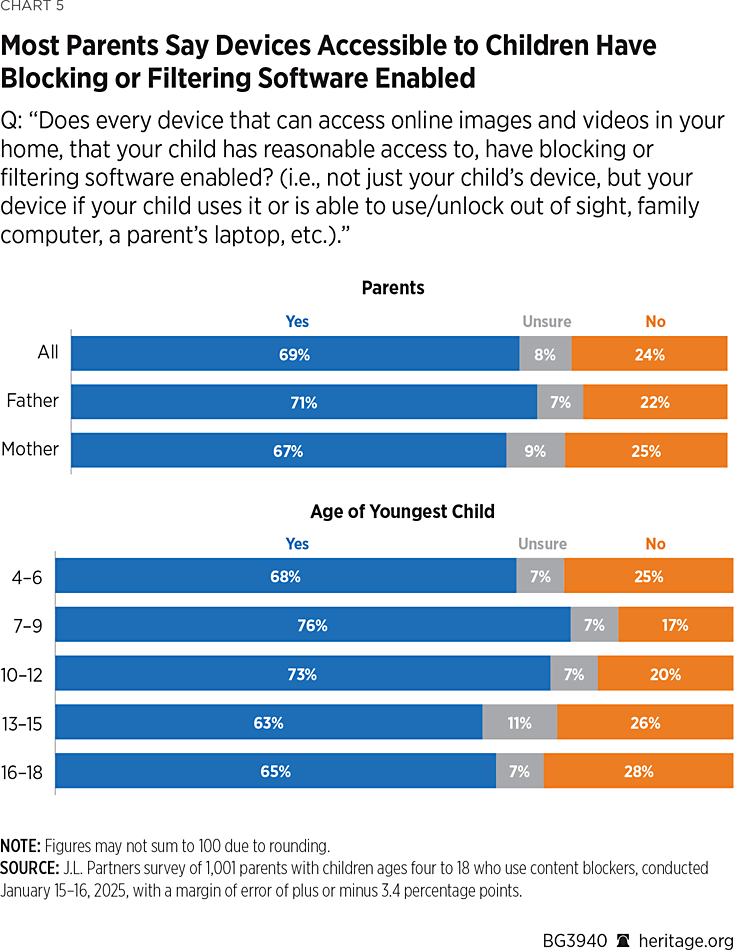
The results of this survey support claims that children may unintentionally or intentionally access pornography even when filters are enabled. Eighteen percent of parents said that their children are able to turn off or circumvent the filtering or blocking software. Unsurprisingly, parents were more likely to say that their teenagers were able to do so than their younger children. Twenty-three percent of 16-to-18-year-olds, 21 percent of 13-to-15-year-olds, 15 percent of 10-to-12-year-olds, 13 percent of seven-to-nine-year-olds, and even 16 percent of four-to-six-year-olds were reported as able to circumvent software.
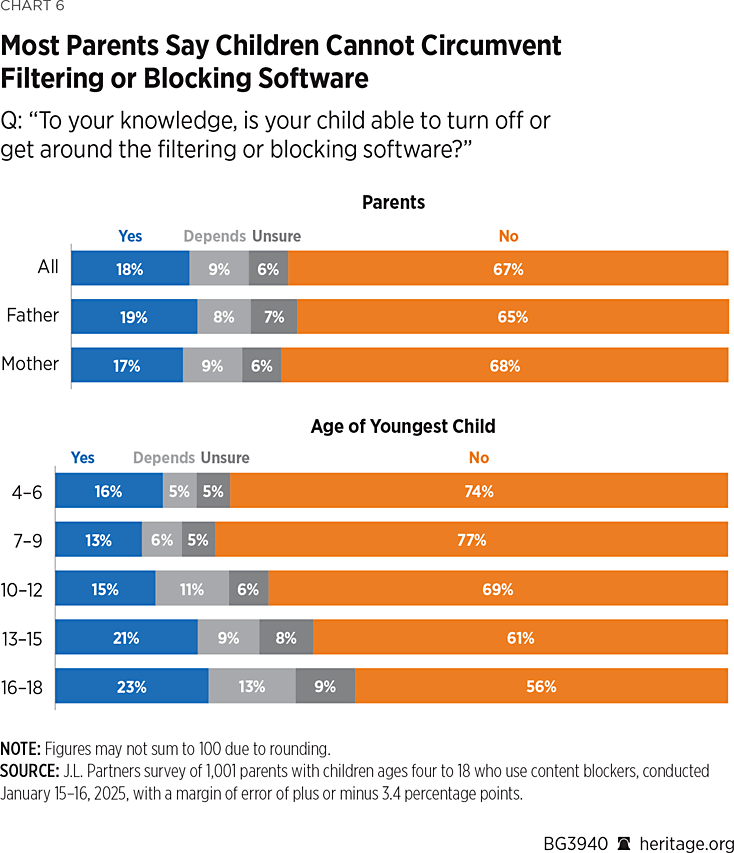
Despite these findings, parents are highly confident that content blockers are effective at stopping their children from seeing “things they do not want them to see.” Fifty percent are very confident, 43 percent are somewhat confident, and only 1 percent are somewhat unconfident. This illustrates the trust that parents place in filters and blocking technology to protect their children. The reality is that the technology does not consistently shield children.
Access to Porn with Filters and Differences Between Moms and Dads
Seventeen percent of parents said that their children have unintentionally accessed online pornography when filtering or blocking software was in place, and 11 percent were unsure. The numbers were similar for children in every age group: 18 percent of four-to-six-year-olds, 16 percent of seven-to-nine-year-olds, 18 percent of 10-to-12-year-olds, 17 percent of 13-to-15-year-olds, and 18 percent of 16-to-18-year-olds unintentionally accessed porn while protective software was in place. Fewer parents reported that their children intentionally accessed online pornography, with 15 percent of parents reporting “yes” and 8 percent “unsure.”
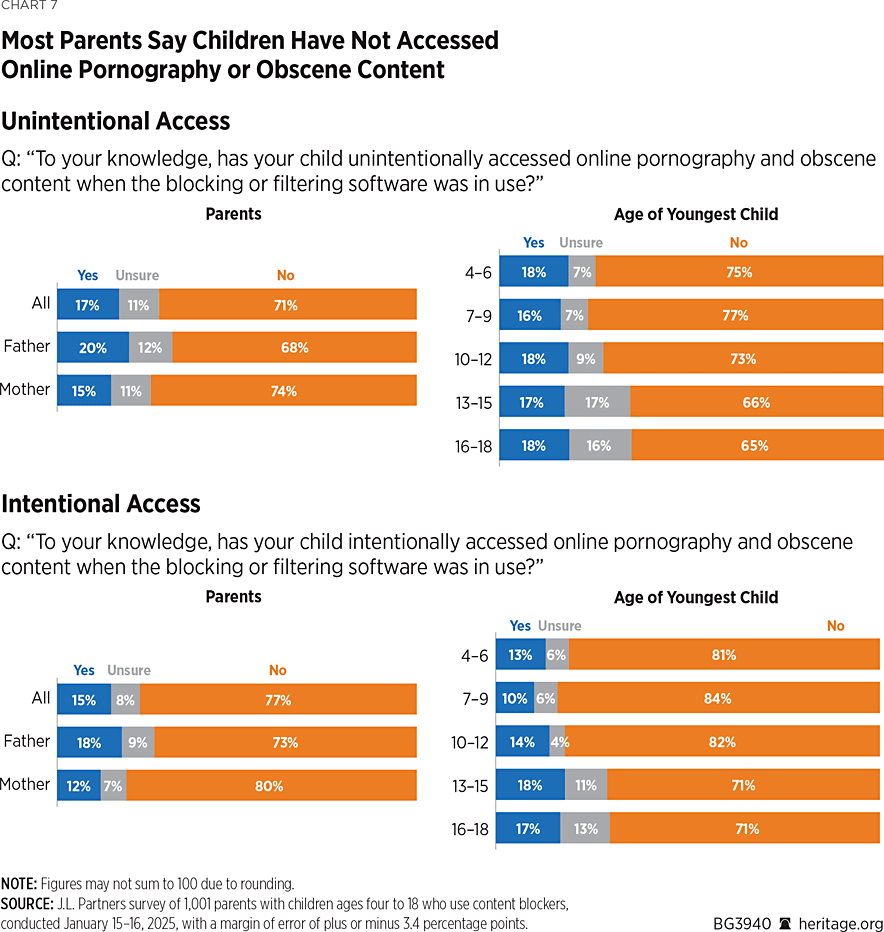
Interestingly, parents reported similar numbers for themselves. One in five (18 percent) parents said they unintentionally accessed online pornography while the software was enabled, and one in six (16 percent) parents said they intentionally accessed online pornography while the software was enabled. Moms and dads answered similarly for previous questions but there was a wider gap here. For dads, the number jumped up to 24 percent, and for moms, it dropped to 14 percent for unintentional access to porn. Twenty-one percent of dads, compared to 12 percent of moms, said they had intentionally accessed porn while the software was enabled. The survey did not ask parents about access while the software was disabled.
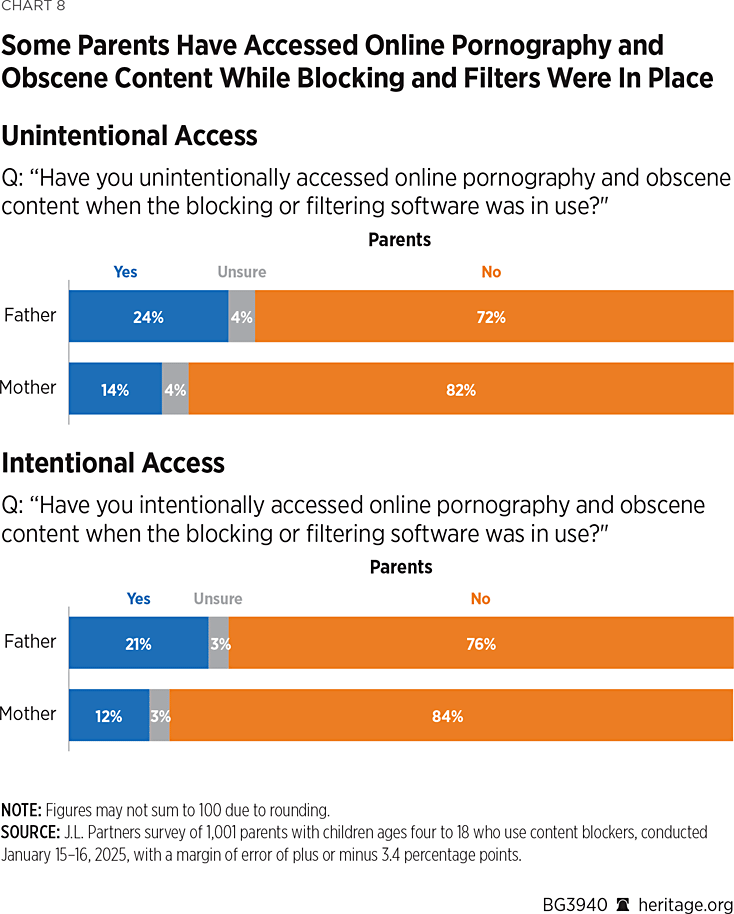
Fifty-one percent of parents said that the software works 100 percent of the time, 42 percent said it worked most of the time, 6 percent answered some of the time, and 1 percent answered never. Again, a wide gap emerged between men and women, with 45 percent of dads saying it works all of the time, compared to 55 percent of moms. The findings coincide with how moms and dads differed in their rates of unintentional and intentional access to pornography.
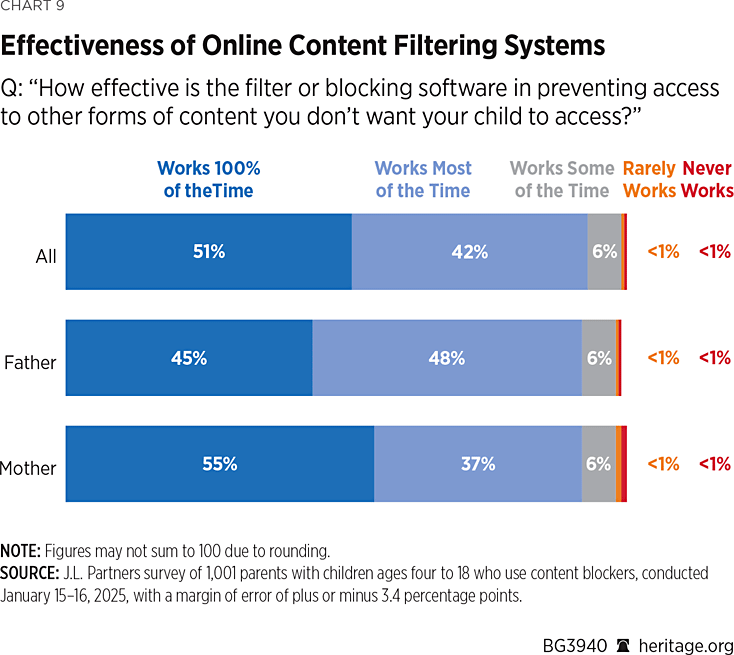
Over-Filtering and Over-Blocking
The results of this survey support the claim that filters are over-inclusive. Parents were asked whether using filters negatively affected their own or their child’s online experience, such as an inability to conduct successful search queries for non-pornographic material. An astounding 41 percent of parents said most of the time or all of the time, and 20 percent sometimes. Only one in three parents said that a filter never impeded their child’s online search experience.
Parents reported at high rates that using filters negatively affects their or their children’s ability to conduct search queries for non-pornographic material. Sixty-one percent of parents said that it affected their searches, and the results were similar for moms and dads. Fifty-six percent said that filters over-block or over-filter search results for legitimate medical or treatment information, 53 percent said filters over-block or over-filter search results for healthy relationships, and 65 percent said filters over-block or over-filter search results for information on drugs and alcohol.
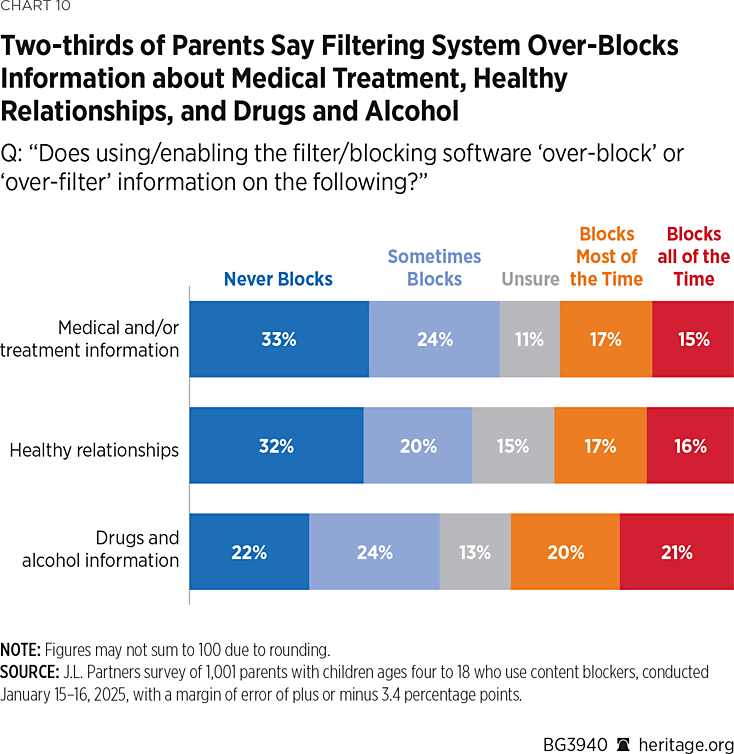
Overly inclusive filters may stop some parents from using them. If filters interfere with their or their children’s regular user experience, such as providing poor search results or unnecessarily filtering websites or search results, parents may turn them off or disable them and forget to turn them back on, or they may choose not to use them at all. Additionally, many browser and built-in filters can be easily disabled by children. Over-inclusivity and the barrier it presents are likely the greatest deterrents to using or requiring filters.
Access to Devices without Filtering and Blocking Software Outside the Homes
One in three (32 percent) parents reported that their child had access to devices outside the home that do not use blocking or filtering software, and 14 percent of parents were unsure. Again, dads reported higher numbers, at 40 percent, than moms, at 26 percent. Their responses did not differ among those who answered unsure. Parents named school and friends’ homes as the main places where their children accessed devices without filtering and blocking software.
The Children’s Internet Protection Act of 2000 requires schools and libraries to block or filter online access to obscene or harmful content on school and library Wi-Fi and devices as a condition of receiving E-Rate funds from the Federal Communications Commission, and parents were made aware of this in the survey question. The federal requirement does not include students’ personal devices with data plans. A friend’s home or school (where friends might bring personal devices) were the most common locations for such access. Less common responses included grandparents’ homes, homes of other relatives, and libraries.
Conclusion
Filtering and blocking software can shield children from obscene content, and it is worth enabling for children, but it does not work consistently. Children can disable or bypass it, and it is not present on every device they access, especially outside the home. Such software is a useful tool for parents, but they should not rely on it as the sole safeguard against their children accessing obscene content or other restricted content. In fact, parents should assume that their children will come across restricted content online even with filters in place and need to take additional measures to protect their children.
Filtering and blocking software can present barriers to successful search queries for non-pornographic content and information. Parents with high screen time tend to model those habits for their kids, who are more likely to have similarly high screen time. Parents need help shielding their children from obscene content, and they require policy solutions that go beyond filtering and blocking software alone.
Annie Chestnut Tutor is Policy Analyst in the Center for Technology and the Human Person at The Heritage Foundation.

